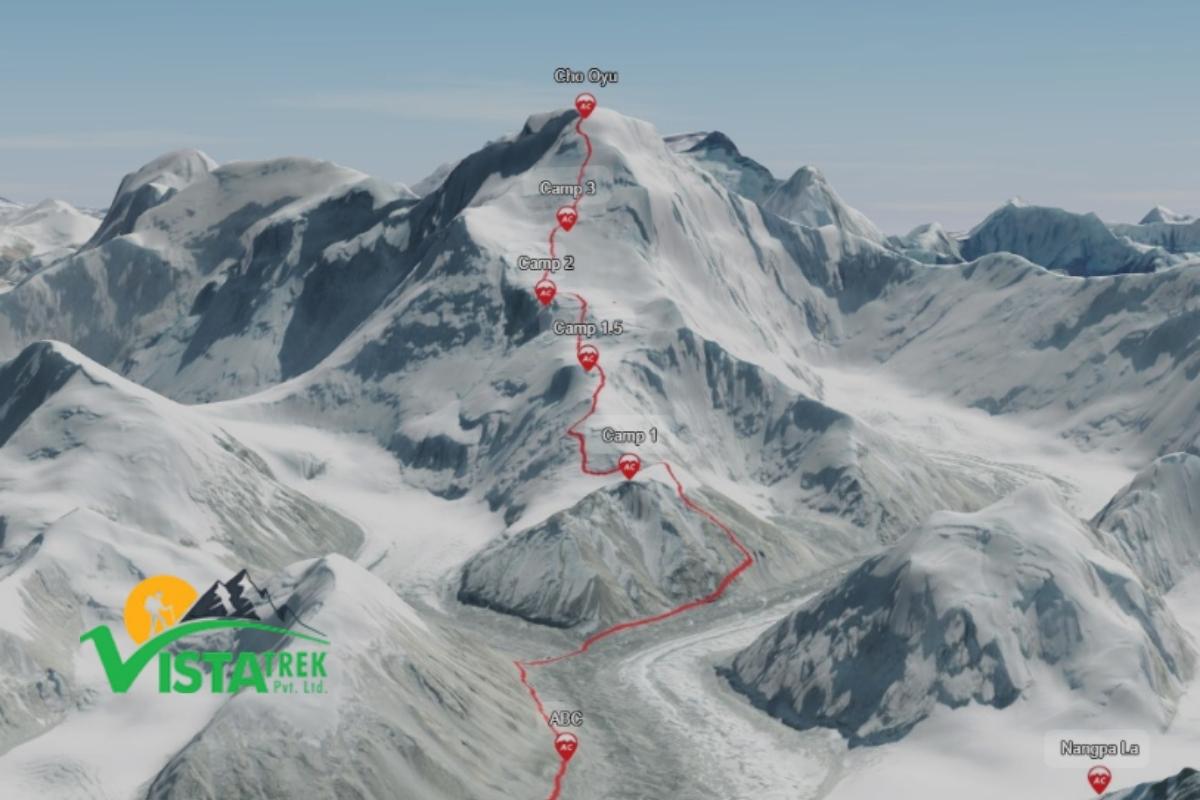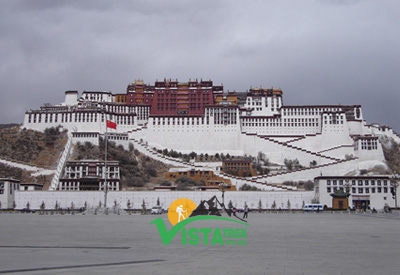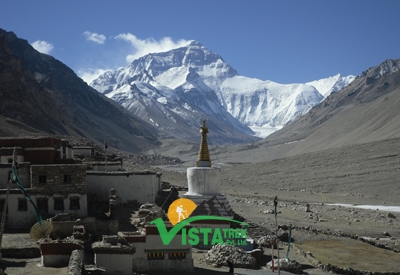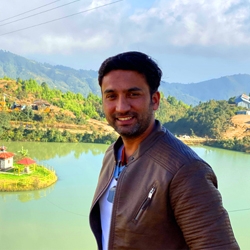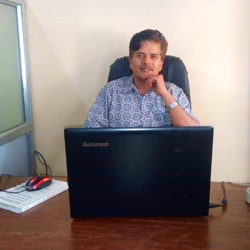Trip Facts
- Duration 43 Days
- Start FromKathmandu
- Group Size1-10 Pax
- End Fromkathmandu
- Trip GradeEasy to Moderate
- Max Height 8199 m
- AccommodationHotel/Lodge/Guesthouses
- TransportationPlane, Helicopter, Private vehicle & Tourist Bus
Best Season
Spring (April-May), Autumn (September-October)
Trip Highlights
- Climb the world’s sixth-highest mountain (8,201m)
- Ideal entry-level 8000m peak with fewer technical sections
- Stunning panoramic views of Everest, Lhotse, and Makalu
- Overland journey from Kathmandu to Lhasa through the Tibetan Plateau
- Explore Tibetan cities like Lhasa and Tingri
- Experience Sherpa and Tibetan culture
- Professional Sherpa support and logistics
Trip Overview
If you’re looking to scale one of the mighty 8000-meter giants without the extreme difficulty of Everest or K2, the Cho Oyu Expedition is your perfect entry point. Situated on the Nepal-Tibet border, Cho Oyu (8,201 meters) is considered the most approachable 8000er, offering climbers a rare balance of high-altitude challenge and technical manageability.
This iconic expedition is not just about climbing—it’s a complete Himalayan experience. Starting from Kathmandu, you’ll prepare for the journey while securing the required permits to enter Tibet. Afterward, a scenic flight takes you to Lhasa, the heart of Tibetan culture. This leg of the trip gives you time to explore the vibrant streets, ancient monasteries, and traditional cuisine of Lhasa, before heading deeper into the Tibetan highlands.
Your overland journey continues through dramatic landscapes and towns like Shigatse and Tingri, each offering glimpses into Tibetan life and rugged beauty. Eventually, you’ll reach Chinese Base Camp, where the real adventure begins. The climbing route progresses through Middle Camp and Advanced Base Camp (ABC), with well-planned acclimatization and rotation schedules to ensure your safety and readiness for the summit push.
The climb to the summit is both exhilarating and humbling. From the top of Cho Oyu, you’ll witness an epic panorama that includes Mt. Everest (8,848m), Nuptse (7,861m), Gauri Shankar (7,134m), and more peaks stretching across the Tibetan range. Although less technical than other 8000-meter peaks, Cho Oyu demands excellent physical conditioning, mental stamina, and strong teamwork.
After your successful summit, the descent retraces the route back to the Chinese Base Camp, followed by the return journey to Lhasa, where you’ll spend one final night immersed in Tibetan culture. A short flight then takes you back to Kathmandu, bringing your adventure to a rewarding close.
Trip Itinerary
You’ll arrive in Kathmandu, Nepal’s bustling capital city, where you’ll be picked up and transferred to your hotel. This is your first chance to relax after your flight and acclimate a bit to the altitude. Later, you’ll meet the expedition team — guides, Sherpas, and support staff — and complete essential paperwork, including medical checks and permits for the climb ahead.
Your guide will take your documents and visit the Chinese Embassy to obtain your Visa. In the meantime, we’ll prepare other necessary documents including climb permits, national park permits, and contracts for you to reach Cho Oyu safely. As you have an additional day in hand, you can set out to explore Kathmandu City and explore some of the most popular UNESCO World Heritage Sites includingPashupatinath Temple, Swayambhunath Stupa, and Boudhanath Stupa. You can visit the local gear shops at Thamel with your guide to purchase needed gear and equipment. Most climbing equipment can be rented as well.
You’ll take a scenic 1.5-hour flight from Kathmandu to Lhasa, the capital of Tibet, after breakfast. Lhasa is a city rich in Buddhist culture and history. After arrival, you check into your hotel and take it easy to recover from the flight and start acclimatizing to the higher altitude. As nothing is planned for today, you can set out to explore the vicinity and explore the evening life at Lhasa Square. Overnight in Lhasa.
You will spend the day acclimatizing before embarking on the trek. As you're above 3500 meters, you must spend a few days getting used to the local weather of Tibet. You can spend the day exploring the city and visiting some of the most popular tourist sites. The sightseeing tour of the city begins with a scenic visit to Potala Palace. Also known as ‘The Winter Palace,’ Potala served as the former royal palace and an administrative office to the Dalai Lama. It is turned into a museum that remains open for all kinds of tourists. You can visit the prayer room, former offices, library and other rooms with artifacts. Next, you can visit the Jokhang monastery or Jokhang Temple located at the heart of Barkhor Street, another historical and popular tourist site. Afterward, you can visit Sera Monastery. Sera is one of the Great Three Gelug university monasteries in Tibet. The monastery lies almost 2km north from your hotel.
Shigatse prefecture lies 271.1km from Lhasa. You’ll begin on a scenic road journey southwest of Lhasa towards Shigatse. The road journey may last almost 5 hours. As an option, you can take a train ride to Shigatse instead. Known as “Tangzhu Ancient Route Train,” the train to Shigatse departs twice a day from the city. The entire route covers almost 248km within three hours. Shigatse lies within the historical Tsang province of Tibet. Along the road journey, you can catch the beautiful sight of the Tibetan landscape and the massive Tsang Po River. Tsang Po is a major River originating inside Tibet that later meets the Brahmaputra River in India. Catch the beautiful sights of Shigatse Dzong, an empty fort, and Tashilunpo Monastery, the official seat of the Panchen Lama (the second revered figure in Tibetan Buddhism after the Dalai Lama). Overnight at a hotel in Shigatse.
You’ll begin on a scenic road journey that takes you further southwest and close to the mountains. The entire journey spans 236.7km, and the ride may last almost 4 hours. Drive along the Tibetan plains and arrive at Shegar. Shegar is the administrative center of Tingri County. It is home to ShegarDzong (Crystal Fort), a fort with one of Tibet’s most fantastic defensive walls. Once at Tingri, you will catch the beautiful sights of Mt. Everest and Mt. Cho Oyu in the distance. You will also meet other climbers at the hotel. Located at 4700 meters, you will visit Basum Primary School -the world’s highest primary school. You will also get to see Rongbuk Monastery, the highest Buddhist monastery in the world. Overnight in Tingri.
Leaving Tingri, you’ll make your way towards the Chinese Base Camp. This brings you close to Cho Oyu Peak. The Chinese Base Camp, located at 5,150 meters, is a short drive from Tingri. Once at the base camp, you can relax and enjoy the beautiful view of the mountains to the south.
You will use this day to acclimatize before approaching the Middle Base Camp. Your guide will organize yaks to help carry the load through the rugged terrain. You will prepare for climbing. At an altitude of 17,000 to 18,000 feet, you must acclimate well. Consider taking a short hike and exploring the area before resting for the night. Overnight in the Chinese Base Camp.
You will not haste and make a short hike towards the Middle Camp or the Intermediate Camp. Once at Middle Camp, you will stay put and acclimatize before approaching Advanced Base Camp at 5608 meters. Today is an acclimatization day. So, you can indulge in a short trek on the moraine. This part of the trail is drier. Catch the amazing sights of Jobo-Rabzang and many other unnamed 6000-meter peaks as you trek alongside the Gyabrag Glacier. Most of the time will be spent acclimatizing. The exact schedule of the climb will be adjusted depending on the need for acclimatization, prevailing health conditions, and weather.
Comprising roughly three weeks, this is the most rigorous and important section of the trip. You will climb the mountain gradually during this period, setting higher camps and acclimatizing to the great altitude.
-
Camp I (6,400m):
Reaching Trekking Camp I is physically hard. You will encounter the infamous "Horrible Hill," a steep scree slope that calls for endurance and cautious footing. This camp acts as your first major rest stop after Base Camp. Here, you’ll continue to acclimatize — allowing your body to adjust to lower oxygen levels — and prepare for the next push higher up the mountain.
-
Camp II (7,000m):
The ascent to Camp II is more technical. You’ll navigate a snow and ice ridge that requires using fixed ropes — ropes anchored into the mountain — and specialized climbing equipment like ascenders (devices that help you climb fixed ropes). This section demands good climbing skills and focus. Camp II is a key acclimatization and staging point for summit preparations.
-
Camp III (7,400m):
Camp III sits on a gentler slope with about a 30-degree incline covered in snow. Although less steep than the previous section, the altitude makes every step challenging. This camp is your final base before the summit bid, so you’ll spend time resting and preparing mentally and physically.
-
Summit Day:
The climb to the summit at 8,201 meters (26,906 feet) is the most demanding part. Expect a long 7 to 10-hour push, crossing a rock band — a difficult rocky section — and then ascending a couloir, a steep, narrow gully filled with snow and ice. The air is extremely thin here, so the climb requires both physical endurance and careful pacing. After soaking in the breathtaking views from the top, you’ll carefully descend back to Advanced Base Camp for rest.
You will take some time recuperating at Advance Base Camp before dismantling the camp and heading back home. After dismantling ABC, you’ll head back to Chinese Base Camp along with a Yak Caravan. From Chinese Base Camp, you’ll make your way back to Shigatse prefecture via Tingri. Overnight at a hotel in Tingri.
You will indulge in a rather exciting drive back to Lhasa viewing the wide, plain valley and the massive Tsang Po River. Once at Lhasa, you will check into your hotel.
After breakfast, you’ll drive to Lukla airport and embark on a scenic trans-Himalayan flight to Kathmandu. Bid farewell to Lhasa and the dominating scenery of Potala Palace, as you cross over the mountains to arrive in Nepal. Enjoy the aerial view of Mt. Everest, Makalu, and Kanchenjunga peaks. Once in Kathmandu, you will check into the hotel.
As a leisure day, you can choose to either relax at the hotel or embark on a city tour. Visit some of the popular UNESCO World Heritage Sites located outside Kathmandu City, such as Patan Durbar Square and Bhaktapur Durbar Square. Enjoy a delicious farewell dinner in one of the finest Nepali restaurants in Thamel. Care to share your holiday experience with us over dinner. Shop for souvenirs at Thamel.
Enjoy your breakfast at the hotel. Depending on your flight schedule, you’ll be transferred to Tribhuvan International Airport for your departure. This day marks the end of your incredible journey. You’ll leave with unforgettable memories of your Cho Oyu expedition and the stunning Himalayas.
Cost Includes
- All airport transfers
- Tibet entry and climbing permits
- Hotel accommodation in Kathmandu and Lhasa
- All meals during the expedition
- Transportation Kathmandu-Lhasa-Tingri by overland jeep
- Professional climbing Sherpas
- Group climbing equipment (ropes, tents, etc.)
- Oxygen cylinders and masks
- Base camp and high-altitude tents
Cost Excludes
- International airfare
- Personal climbing gear
- Travel and rescue insurance
- Personal expenses (wifi, battery charging, snacks)
- Tips for guides and Sherpas
Useful Info
Altitude Acclimatization
Acclimatization is one of the most crucial factors for the success and safety of any high-altitude expedition, especially when climbing an 8000-meter peak like Cho Oyu (8,201m). Rapid gain in elevation can lead to Acute Mountain Sickness (AMS), which can become severe if not managed properly.
That’s why we follow a tried-and-tested rotation schedule—you’ll gradually ascend from base camp to higher camps and return multiple times before the summit push. This systematic approach allows your body to adapt to decreasing oxygen levels, significantly improving your chances of reaching the summit safely.
Tibet Entry Permits
Since Cho Oyu lies on the Tibet (China) side of the Himalayas, special permits are required to enter and travel within Tibet. These include the Tibet Travel Permit, the Aliens’ Travel Permit, and the Mountaineering License issued by Chinese authorities.
Our team at Vista Treks handles the entire permit process on your behalf. However, we strongly recommend preparing and submitting your passport and travel documents well in advance—at least 6–8 weeks before departure—to ensure timely processing and avoid delays.
Oxygen Support
Climbing above 7,000 meters exposes the body to extreme levels of hypoxia (low oxygen). That’s why we provide high-quality oxygen systems throughout the expedition.
Our oxygen support includes:
- Certified oxygen cylinders (Poisk or Summit brand)
- Reliable regulators and masks
- Proper instruction on usage before the summit push
Oxygen is typically used during the final ascent and is also available for emergency use at higher camps.
Experience Requirement
While Cho Oyu is often described as one of the more “approachable” 8000-meter peaks, it is still a serious expedition with harsh conditions and prolonged exposure to high altitude.
For safety and success, climbers are expected to have:
- Prior experience at altitudes above 6,000 meters
- Familiarity with fixed ropes, crampons, and ice axe techniques
- A strong level of physical fitness and mental endurance
If you’ve previously climbed peaks like Island Peak, Mera Peak, or Lobuche East, you’ll be in a great position to take on Cho Oyu.
Communication and Emergency Contact
Reliable communication is a lifeline in the mountains. At higher camps, where there’s no cell signal, we provide satellite phones to maintain contact with base camp and for emergency communication if needed.
This ensures that we can coordinate rescue operations, stay in touch with loved ones, and adapt plans as needed based on weather or health conditions.
Best Seasons to Start the Cho Oyu Expedition
Timing is everything when planning a high-altitude climb. The best times to attempt Cho Oyu are spring and autumn, which offer the most favorable weather windows:
- Spring (April–May)
- Weather: Relatively stable with less snowfall and moderate temperatures
- Climbing Conditions: Ideal snowpack for safe ascent
- Visibility: Good views, though slightly hazier skies due to pre-monsoon moisture
- Advantages: Warmer conditions at higher camps, less wind in late spring
- Autumn (September–October)
- Weather: Post-monsoon clarity brings stunning blue skies and dry air
- Climbing Conditions: Firmer snow and lower avalanche risk
- Visibility: Excellent for panoramic views of Everest, Lhotse, Nuptse, and surrounding peaks
- Advantages: Fewer climbers than in spring, offering a quieter mountain experience
Both seasons provide great summit opportunities, but your choice may depend on whether you prefer warmer climbing temperatures (spring) or sharper, clearer views (autumn). Our guides and logistics team are experienced in both seasons and can help tailor your expedition plan accordingly.
Trip FAQ's
Cho Oyu is considered the easiest of the 8000m peaks, but still demands excellent fitness and altitude experience.
Yes, previous high-altitude experience is highly recommended (above 6000m).
Yes, supplemental oxygen is used above Camp 2 and especially on summit day.
Yes, we offer rental options in Kathmandu for essential gear.
A Tibet entry permit, a climbing permit, and travel insurance are mandatory. We help with all logistics.




